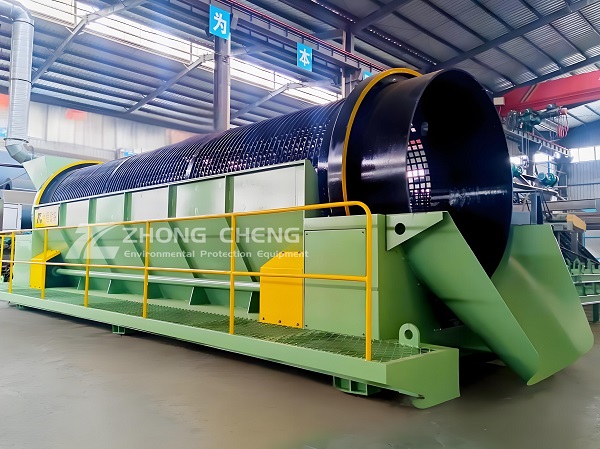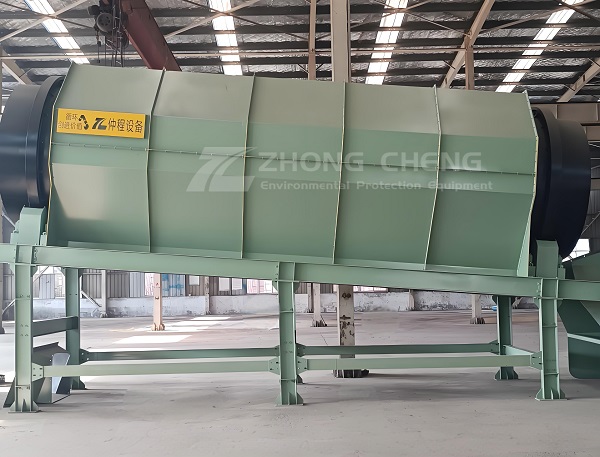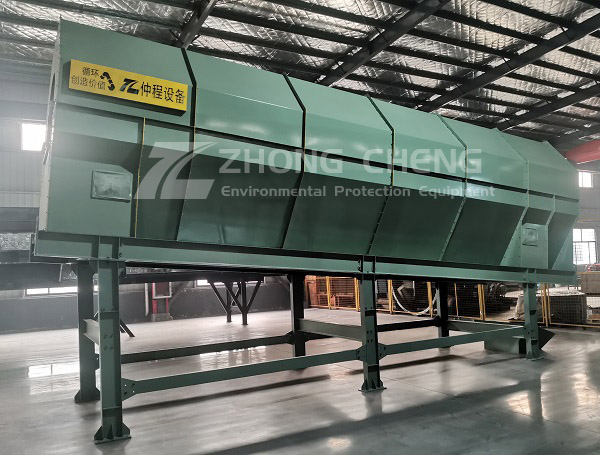The current industrial sorting field demands increasingly higher precision in material handling, greater resilience to complex working conditions, and greater intelligence. Traditional drum screens, with their single-axis drive and fixed screen aperture design, are no longer sufficient. The latest drum screens, released in 2025, represent a technological leap, moving from single-axis rotation to multi-axis collaboration, and from manual operation to intelligent control, demonstrating strong advantages in the sorting of complex materials across multiple industries. While the following section has already analyzed its technological breakthroughs and features, this section first clarifies its key role in modern industrial production, laying the groundwork for subsequent content.

As a "mainstay grading device" in industrial sorting, the drum screen uses a rotating cylinder to tumble materials, achieving particle size classification through screen aperture dimensions. It is widely applicable to various industries, including mining, waste treatment, and building materials. With the upgrading of material sorting requirements towards "high precision, resilience to complex working conditions, and intelligence," drum screens have achieved a technological leap from traditional single-axis rotation to multi-axis collaboration, and from manual operation to intelligent control. This article, based on the latest industry achievements in 2025, systematically analyzes the core technological breakthroughs and typical characteristics of drum screens, showcasing their core value in adapting to modern industrial production.
Breakthrough in Core Technology of Latest Rotary Drum Screens: An Upgrade from "Passive Screening" to "Active Adaptation"
Traditional rotary drum screens, limited by single-axis drive and fixed screen hole design, are prone to clogging and low screening accuracy when handling complex materials with high moisture content, viscosity, and entanglement. The latest technology, through structural innovation, intelligent control, and material upgrades, constructs a technical system of "dynamic adaptation - intelligent regulation - self-cleaning guarantee," completely solving the pain points of traditional methods.
1. Multi-axis Linkage Structure Technology: Solving the Problem of Sorting High-Moisture, High-Viscosity Materials
For materials containing entanglement and prone to clumping, such as household waste and construction waste, the latest rotary drum screen introduces a multi-axis collaborative dynamic design, breaking the traditional single-axis rotation mode. It achieves efficient screening through differential drive and counter-rotation. Adjacent rollers are arranged with alternating high and low speeds, utilizing the speed difference to generate shearing force, which can break up entangled materials such as plastic bags and fibers and propel the material forward; some rollers convey materials in the forward direction, while others rotate in the reverse direction to break up clumped materials such as kitchen waste, preventing accumulation and clogging.

In terms of structural adaptability, this technology achieves dynamic gap adjustment, allowing real-time adjustment of the roller spacing (50-200mm steplessly adjustable) via hydraulic or electric devices. It can quickly switch between different particle sizes in construction waste, such as concrete blocks (>100mm), wood (50-100mm), and gypsum board fragments (<50mm), completing multi-stage grading without replacing the screen. An application in a construction waste sorting project in Hami shows that after adopting multi-axis linkage technology, the material blockage rate was reduced by 70%, and the continuous operating time was extended from 2 hours with traditional equipment to over 8 hours.
2. Intelligent Sensing and Adaptive Control Technology: Achieving Dynamic Matching of Operating Conditions The latest drum screen integrates multimodal sensor fusion and AI control algorithms to construct a closed-loop control system of "perception-decision-execution". The equipment is equipped with pressure sensors, an infrared moisture detector, and an AI vision system, enabling real-time monitoring of material moisture content (e.g., 40%-60% moisture content in high-moisture municipal solid waste), accumulation thickness, and composition changes. Based on a PLC and edge computing platform, adaptive algorithms dynamically optimize the combination of roller speed, gap, and rotation direction—automatically reducing the speed difference to minimize adhesion when high-moisture materials are detected; and immediately adjusting the gap to prevent equipment damage when hard impurities are detected.
For automated operation and maintenance, the equipment features a fault self-diagnosis and redundancy backup system. Each roller is driven by an independent variable frequency motor (supporting stepless speed regulation from 0-30 rpm). In the event of a motor failure, the system automatically switches to a backup drive to ensure continuous production line operation. An IoT module allows remote monitoring of equipment operating parameters, enabling intelligent operation and maintenance functions such as screen wear warnings and lubrication cycle reminders, reducing maintenance response time by 60%.
3. Self-cleaning and Material Upgrade Technology: Enhancing Equipment Durability and Stability
Addressing screen clogging and wear issues, the latest technology upgrades the system in three aspects: anti-sticking, clogging removal, and wear resistance. The roller surface is coated with a high-chromium alloy steel and wear-resistant rubber composite, and coated with nano-hydrophobic materials (contact angle > 150°), reducing the coefficient of friction by 40% and minimizing the adhesion of highly moist materials. Built-in elastic scrapers and a 0.5-0.8MPa high-pressure air jet device remove entangled materials in real time. A high-frequency micro-vibration module (20-50Hz) at the bottom of the screen frame accelerates the discharge of undersize materials, completely solving the problem of screen clogging.
Regarding the durability of key components, the screen adopts a combined ring-shaped flat steel structure (cross-sectional area of 16mm × 12mm), far exceeding the strength of traditional screen bars, extending its service life by 2-3 times. The bearings feature a self-lubricating design, extending the maintenance cycle from 3 months to 6 months. The modular quick-disassembly structure of the single roller reduces replacement time to less than 30 minutes, significantly reducing operating costs.
Typical Features of the Latest Rotary Cylinder Screen: Performance Advantages Adaptable to Complex Working Conditions

Based on the aforementioned technological breakthroughs, the latest rotary cylinder screen exhibits significant advantages in screening efficiency, environmental friendliness, and economy, perfectly meeting the modern industrial demand for "high efficiency, environmental protection, and low consumption."
1. High Screening Accuracy and Wide Adaptability: Covering Complex Materials Across Multiple Industries
Through dynamic gap adjustment and intelligent control, the latest rotary cylinder screen achieves multi-stage dynamic screening, with an error rate controlled within 5%, far exceeding the 15%-20% error rate of traditional single-shaft rotary cylinder screens. Its processing particle size range extends from fine powder below 3mm to large materials above 300mm. It can separate ores of different particle sizes in the mining industry, accurately separate humus and impurities (purity ≥85%) in municipal solid waste treatment, and achieve precise grading of coarse, medium, and fine sand in the building materials industry.
Customized configurations are available to suit different industry characteristics: The coal industry uses wear-resistant screens to handle wet, sticky materials such as coal gangue and coal slime; the construction industry uses impact-resistant rollers to handle hard materials such as concrete blocks; and the environmental protection industry is equipped with a fully sealed structure to handle municipal solid waste, truly achieving "one equipment for multiple scenarios."

2. Strong Anti-clogging Capability: Ensuring Continuous and Efficient Operation The combination of multi-axis differential speed design, self-cleaning system, and anti-sticking materials gives the latest drum screen extremely strong anti-clogging capabilities. In high-moisture municipal solid waste treatment, fiber entanglement rate is reduced by 70%; in compound fertilizer production, the plate-type cleaning mechanism, through relative movement with the screen body, can continuously "comb" sticky and wet materials, ensuring the screen remains clean at all times. Data from a landfill waste treatment project shows that the equipment can operate continuously for 24 hours without manual cleaning, with a processing capacity of 200-500 tons/hour, which is 3-5 times that of traditional equipment.
3. Energy Saving and Environmental Protection: Meets Green Production Requirements
In terms of energy saving, the intelligent speed control system dynamically adjusts the motor power according to the material load, reducing the power consumption per ton of processing to 0.9-1.5 kW·h, saving 30%-40% compared to traditional equipment (1.8-2.5 kW·h). The reduction gear transmission design further reduces the motor power requirement, resulting in significant energy savings over long-term operation. In terms of environmental protection, the equipment adopts a fully sealed structure, combined with a dust cover and noise reduction design, completely eliminating dust pollution during the screening process. Noise is controlled below 75 decibels, meeting national air pollutant and noise emission standards.
4. Low Operation and Maintenance Costs: Balancing Short-Term Investment and Long-Term Benefits

Although the initial investment in the latest rotary drum screen is higher, comprehensive cost optimization is achieved through "long-life components + intelligent operation and maintenance + low energy consumption." High wear-resistant materials extend the screen replacement cycle to 1-2 years, self-lubricating bearings reduce maintenance frequency, and modular design reduces maintenance difficulty. Overall operation and maintenance costs are reduced by more than 50% compared to traditional equipment. A case study from a coal mining company shows that the equipment's return on investment exceeded 200% within three years, far surpassing the short-term low-cost advantage of traditional equipment.
The latest technological breakthrough in rotary drum screens not only solves the performance pain points of traditional equipment but also promotes the optimization of sorting processes at the industry chain level: In the waste treatment sector, its efficient grading provides purity assurance for subsequent resource recycling (such as food waste fermentation and plastic recycling); in the mining industry, precise screening improves concentrate grade and reduces subsequent smelting costs; in the building materials industry, automated screening ensures stable quality of sand for concrete, contributing to the upgrading of project quality.
Supported by core technologies such as multi-axis linkage, intelligent control, and self-cleaning, the latest rotary drum screen exhibits high precision, anti-clogging, energy-saving and environmentally friendly characteristics, and low operation and maintenance costs, completely reshaping the application boundaries of traditional rotary drum screens. With the further integration of intelligent technology and materials technology, rotary drum screens will upgrade towards "AI-powered fully autonomous operation" and "multi-equipment collaborative sorting," continuously providing core equipment support for cost reduction, efficiency improvement, and green development across various industries.
The latest rotary drum screen, thanks to technological breakthroughs such as multi-axis linkage, intelligent sensing, and self-cleaning, solves the pain points of traditional equipment, including clogging and low precision, while also featuring high precision, strong adaptability, energy saving, and environmental friendliness. It not only optimizes sorting processes across various industries but also supports cost reduction, efficiency improvement, and green production. In the future, with the deepening integration of AI and materials technology, it will develop towards fully autonomous operation and multi-device collaboration, continuously expanding the application boundaries of industrial sorting.